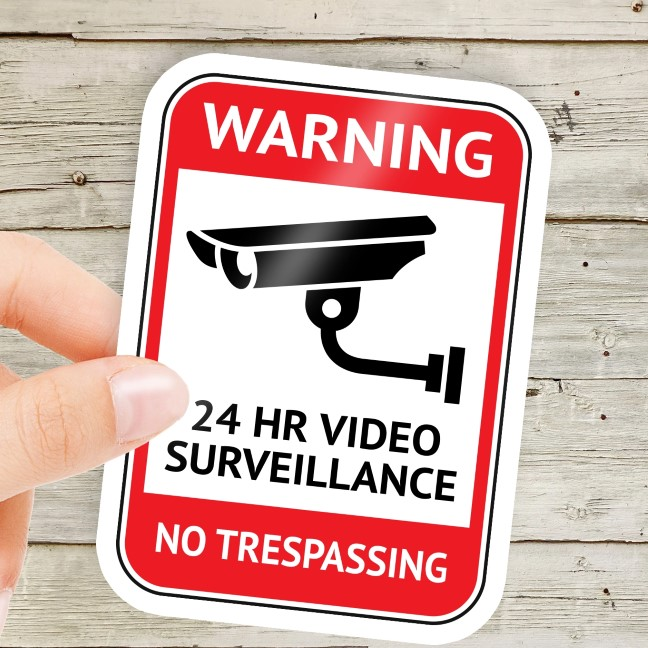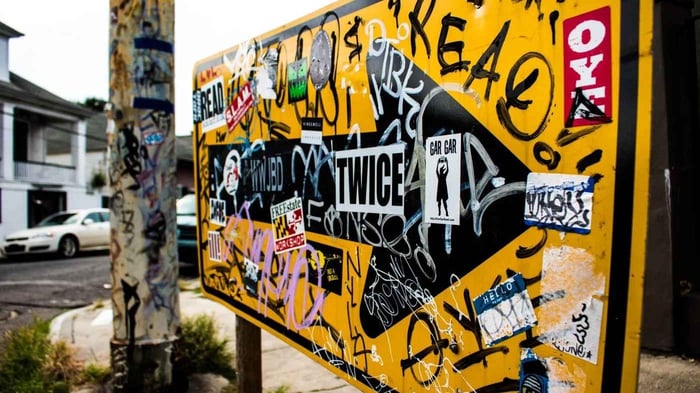Stickers, including bumper stickers and other decals, have become a prevalent form of self-expression in urban environments. They are seen as fun and cool, and many people place them on their water bottles, laptops, or car. You may have also noticed them adorning your local street, stop sign, highway fence, or lamppost, and sometimes even turning up on somebody else’s car, which can cause a whole different situation.
With more stickers popping up in a public post such as these, the question often arises: is stickering (or putting a sticker) considered graffiti, and is it illegal? You might guess that it could be labeled as criminal damage, but the answer is not always straightforward. The perception of stickering—also known as sticker slapping—as graffiti or art varies based on personal opinions, cultural perspectives, and even local laws.

The subjective nature of stickering lies in the blurred line between graffiti and art. While some view stickering as a form of artistic expression, others perceive it as an act of vandalism that might mar the paint on vehicles or public surfaces. This distinction often hinges on individual viewpoints and the cultural context in which stickering takes place. The debate about whether it’s creative or wrong raises questions about the boundaries of public expression and personal interpretation.
Is Stickering Considered Vandalism?
Determining whether stickering is considered vandalism depends on various factors, including the legality and enforcement of sticker graffiti laws, as well as the potential for stickering to become a nuisance. In many jurisdictions, placing stickers on public property or on someone else’s car without permission is seen as an unauthorized posting and can lead to legal consequences. You could face a ticket, receive a warning, or even encounter misdemeanor charges. In worse cases, local police might treat repeated sticker slapping as criminal damage.
Enforcement varies widely. Some cities and municipalities actively prosecute those who engage in extensive stickering, while others focus on larger crimes. Yet, if sticker placements become widespread or start causing public complaints—like blocking a window, obscuring a parking sign, or defacing personal property—the odds of a driver getting fined or taken to court increase.
Evaluating if stickering becomes a nuisance involves looking at the impact of these stickers. Placing decals on a traffic control device or stop sign could obstruct vital information and pose safety risks. In addition, large-scale sticker bombing—sometimes covering entire surfaces—creates visual clutter and degrades public spaces. This is especially problematic when it damages or obstructs public infrastructure, leaving the city to foot the cost of removal.
If you break and enter a private or public facility to put stickers everywhere, you’re likely to face extra penalties beyond vandalism. In such a situation, it’s best to imagine the potential outcomes before you decide to proceed. As with many things, exercising care and thinking ahead can keep you from landing in hell for a simple act of self-expression.
Understanding the Legalities

It’s crucial to differentiate between private property and public places when it comes to stickering. Putting stickers on personal property—like sticking them to a friend’s car without permission—can be considered trespassing. Unless you have explicit consent, keep your stickers to yourself, your own bumper, or your water bottle.
Sticker placement on public property, like a lamppost or an awning post, can fall into a legal gray area. Some cities have strict ordinances, while others have more lenient policies so long as the stickers don’t present safety issues or visual pollution. Still, placing stickers on a traffic sign or utility pole without authorization might be deemed illegal.
Always review local regulations and, if necessary, contact the relevant authorities. In some places—like certain parts of Portland—the city might consider multiple stickers a form of graffiti. If you’re unsure, look for guidelines online or decide to reach out to a security or legal firm for clarity. With so many different rules, a little research can save you time and money, not to mention the possibility of getting sued or slapped with a fine.
Safe and Responsible Sticker Practices

To engage in stickering responsibly, focus on identifying suitable locations where stickers won’t obstruct traffic signs or cause hazards. Think about using removable adhesives or even magnets, which allow for easy removal without damaging surfaces. If you’re placing a sticker on your own bumper, remember that a little heat from a hair dryer can help loosen the glue during a future removal.
When placing stickers on private property, always seek the owner’s consent. This can help you avoid being labeled rude or risking a confrontation that might escalate into “sticker rage.” If the property belongs to a guy who’s already had problems with sticker vandals, your approach and respect can make a big difference in his response.
Also, keep in mind that certain stickers—like ones featuring artwork or logos—could infringe on copyrights if used without permission. Misusing trademarked images can lead to additional legal issues on top of any vandalism charges. A wise approach is to keep your designs original and your placements conscientious.
Potential Penalties for Stickering

Engaging in stickering activities without considering the legal implications can potentially lead to various penalties and consequences. While stickering is generally seen as a form of self-expression, it's important to understand that there are potential legal ramifications associated with unauthorized stickering. Let's explore some of the potential penalties that individuals may face if they engage in stickering practices that cross into illegal territory.
In rare cases, stickering can result in prosecution and misdemeanor charges. While the enforcement of stickering laws may vary depending on the jurisdiction, there have been instances where individuals have faced legal action for their involvement in unauthorized sticker placement. These cases typically occur when stickering activities are excessive, widespread, or cause significant damage to public or private property (for instance, ripping off paint on a car or leaving rude messages on somebody else’s car).
The potential penalties for stickering can include fines, warnings, or additional penalties. The severity of these consequences may vary depending on the jurisdiction, the extent of the stickering violation, and the perceived impact on public spaces. It's important to note that even if enforcement of stickering laws may not be prevalent in certain areas—such as some neighborhoods in Portland—it doesn't mean there are no risks involved. It's crucial to understand and respect the laws and regulations of the specific jurisdiction to avoid potential penalties, whether that means a hefty ticket, being sued, or even having to appear in court.
Additionally, it's worth noting that stickering can lead to other legal issues if it involves the unauthorized use of copyrighted or trademarked materials. Placing printed materials, such as decals with copyrighted images or logos, without permission can potentially result in a separate violation related to intellectual property rights.
In summary, while stickering is often seen as a form of self-expression and a way to engage with public spaces, it's essential to be aware of the potential penalties and legal implications. Engaging in stickering practices without proper authorization can result in prosecution, misdemeanor charges, fines, warnings, and additional penalties. To avoid these consequences, it's important to understand and respect the laws and regulations of the specific jurisdiction and seek permission when necessary. By practicing responsible stickering and being mindful of the potential legal risks, individuals can engage in this form of self-expression while minimizing the chances of facing penalties or legal troubles.
Exploring Sticker Culture

Sticker culture has evolved into a vibrant and multifaceted phenomenon, encompassing various forms of self-expression and advertisement. Sticker art serves as a means for individuals to convey their ideas, messages, and artistic expressions to a wide audience. Stickers offer a portable and accessible medium for artists and enthusiasts to share their creativity in public spaces. From political statements to whimsical designs, it allows for diverse forms of personal expression.
One intriguing aspect of sticker culture is the practice of trading stickers. Within subcultures and artistic communities, sticker trading has become a popular way to connect with fellow enthusiasts and artists. This exchange of stickers fosters collaboration, creativity, and the spread of ideas. It also enables artists to share their work beyond their local spheres and gain recognition in wider networks.
The creativity and ingenuity in sticker placements further contribute to the richness of sticker culture. Stickers can be found in unexpected and imaginative locations, adding an element of surprise and delight to the urban landscape. For example, stickers creatively placed on street signs, bus shelters, or public utility poles can transform mundane objects into beautiful and interesting sights. These captivating sticker placements imagine new ways of interacting with the environment, providing moments of visual interest and sparking conversations within the community.
Final Thoughts

In conclusion, stickering is a form of self-expression that blurs the line between graffiti and art. Its perception varies, and while some view it as a creative means of communication, others consider it vandalism. Understanding the legal implications and practicing responsible stickering is crucial to avoid potential penalties and respect public spaces.
By adhering to local regulations, seeking permission when necessary, and considering the impact on the environment, individuals can engage in stickering in a safe and respectful manner. Sticker culture offers a diverse and dynamic space for artistic expression and community engagement. Embracing the creativity and exploring the boundaries of stickering can contribute to a vibrant and inclusive public art culture.
Frequently Asked Questions (FAQ)
- Q: Is stickering considered graffiti? A: Stickering can be perceived as a form of graffiti depending on how it is executed and the context in which it takes place. While some view stickering as a creative and artistic form of self-expression, others may consider it a form of vandalism.
- Q: Is stickering illegal? A: The legality of stickering depends on various factors, including local laws and regulations. In many jurisdictions, placing stickers on public property without permission is considered an unauthorized posting and can lead to legal consequences.
- Q: Can I put stickers on stop signs or other public property? A: Placing stickers on stop signs or other public property without proper authorization is generally prohibited and may be considered a violation of the law. It is important to be aware of and adhere to local regulations regarding sticker placement.
- Q: Do I need consent to place stickers on private property? A: Yes, it is important to seek consent from the property owner before placing stickers on private property. Placing stickers without permission can be considered trespassing and may result in legal consequences.
- Q: Can I trade stickers with other people? A: Yes, trading stickers is a common practice within sticker culture. It allows artists and enthusiasts to connect, collaborate, and share their work. However, it is important to ensure that the stickers being traded are placed responsibly and do not violate any laws or regulations.
- Q: What are the potential penalties for unauthorized stickering? A: Engaging in unauthorized stickering can potentially result in any number of penalties. You may receive a fine, warning, or even misdemeanor charges, depending on the jurisdiction and the extent of the violation. It is essential to understand and respect the laws and regulations of the specific area to avoid legal consequences.
- Q: How can I engage in stickering responsibly? A: Engaging in stickering responsibly involves respecting the laws and regulations of the specific jurisdiction, seeking permission when necessary, and considering the impact on public spaces. Placing stickers in suitable locations, avoiding damage or obstruction, and adhering to local guidelines are crucial aspects of responsible stickering.
- Q: What is the significance of sticker culture? A: Sticker culture provides a platform for individuals to express themselves creatively, share ideas, and connect with others. It contributes to the vibrancy of public spaces and fosters collaboration and the spread of artistic expressions.






